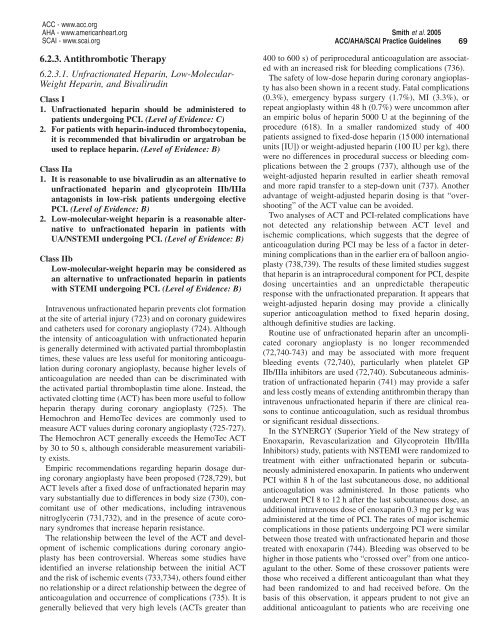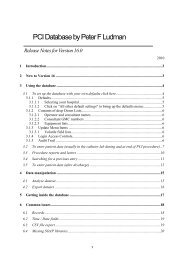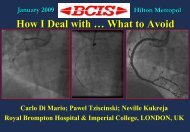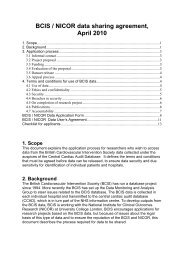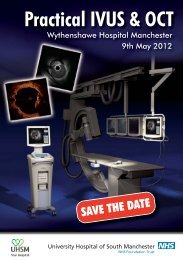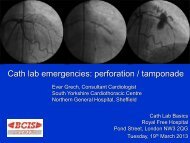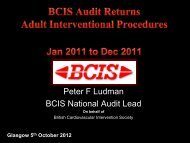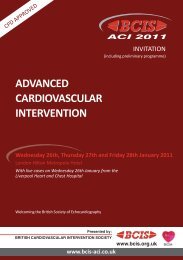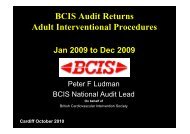Recommendations
ACC/AHA/SCAI PCI Guidelines - British Cardiovascular Intervention ...
ACC/AHA/SCAI PCI Guidelines - British Cardiovascular Intervention ...
- No tags were found...
You also want an ePaper? Increase the reach of your titles
YUMPU automatically turns print PDFs into web optimized ePapers that Google loves.
ACC - www.acc.org<br />
AHA - www.americanheart.org<br />
SCAI - www.scai.org<br />
Smith et al. 2005<br />
ACC/AHA/SCAI Practice Guidelines<br />
69<br />
6.2.3. Antithrombotic Therapy<br />
6.2.3.1. Unfractionated Heparin, Low-Molecular-<br />
Weight Heparin, and Bivalirudin<br />
Class I<br />
1. Unfractionated heparin should be administered to<br />
patients undergoing PCI. (Level of Evidence: C)<br />
2. For patients with heparin-induced thrombocytopenia,<br />
it is recommended that bivalirudin or argatroban be<br />
used to replace heparin. (Level of Evidence: B)<br />
Class IIa<br />
1. It is reasonable to use bivalirudin as an alternative to<br />
unfractionated heparin and glycoprotein IIb/IIIa<br />
antagonists in low-risk patients undergoing elective<br />
PCI. (Level of Evidence: B)<br />
2. Low-molecular-weight heparin is a reasonable alternative<br />
to unfractionated heparin in patients with<br />
UA/NSTEMI undergoing PCI. (Level of Evidence: B)<br />
Class IIb<br />
Low-molecular-weight heparin may be considered as<br />
an alternative to unfractionated heparin in patients<br />
with STEMI undergoing PCI. (Level of Evidence: B)<br />
Intravenous unfractionated heparin prevents clot formation<br />
at the site of arterial injury (723) and on coronary guidewires<br />
and catheters used for coronary angioplasty (724). Although<br />
the intensity of anticoagulation with unfractionated heparin<br />
is generally determined with activated partial thromboplastin<br />
times, these values are less useful for monitoring anticoagulation<br />
during coronary angioplasty, because higher levels of<br />
anticoagulation are needed than can be discriminated with<br />
the activated partial thromboplastin time alone. Instead, the<br />
activated clotting time (ACT) has been more useful to follow<br />
heparin therapy during coronary angioplasty (725). The<br />
Hemochron and HemoTec devices are commonly used to<br />
measure ACT values during coronary angioplasty (725-727).<br />
The Hemochron ACT generally exceeds the HemoTec ACT<br />
by 30 to 50 s, although considerable measurement variability<br />
exists.<br />
Empiric recommendations regarding heparin dosage during<br />
coronary angioplasty have been proposed (728,729), but<br />
ACT levels after a fixed dose of unfractionated heparin may<br />
vary substantially due to differences in body size (730), concomitant<br />
use of other medications, including intravenous<br />
nitroglycerin (731,732), and in the presence of acute coronary<br />
syndromes that increase heparin resistance.<br />
The relationship between the level of the ACT and development<br />
of ischemic complications during coronary angioplasty<br />
has been controversial. Whereas some studies have<br />
identified an inverse relationship between the initial ACT<br />
and the risk of ischemic events (733,734), others found either<br />
no relationship or a direct relationship between the degree of<br />
anticoagulation and occurrence of complications (735). It is<br />
generally believed that very high levels (ACTs greater than<br />
400 to 600 s) of periprocedural anticoagulation are associated<br />
with an increased risk for bleeding complications (736).<br />
The safety of low-dose heparin during coronary angioplasty<br />
has also been shown in a recent study. Fatal complications<br />
(0.3%), emergency bypass surgery (1.7%), MI (3.3%), or<br />
repeat angioplasty within 48 h (0.7%) were uncommon after<br />
an empiric bolus of heparin 5000 U at the beginning of the<br />
procedure (618). In a smaller randomized study of 400<br />
patients assigned to fixed-dose heparin (15 000 international<br />
units [IU]) or weight-adjusted heparin (100 IU per kg), there<br />
were no differences in procedural success or bleeding complications<br />
between the 2 groups (737), although use of the<br />
weight-adjusted heparin resulted in earlier sheath removal<br />
and more rapid transfer to a step-down unit (737). Another<br />
advantage of weight-adjusted heparin dosing is that “overshooting”<br />
of the ACT value can be avoided.<br />
Two analyses of ACT and PCI-related complications have<br />
not detected any relationship between ACT level and<br />
ischemic complications, which suggests that the degree of<br />
anticoagulation during PCI may be less of a factor in determining<br />
complications than in the earlier era of balloon angioplasty<br />
(738,739). The results of these limited studies suggest<br />
that heparin is an intraprocedural component for PCI, despite<br />
dosing uncertainties and an unpredictable therapeutic<br />
response with the unfractionated preparation. It appears that<br />
weight-adjusted heparin dosing may provide a clinically<br />
superior anticoagulation method to fixed heparin dosing,<br />
although definitive studies are lacking.<br />
Routine use of unfractionated heparin after an uncomplicated<br />
coronary angioplasty is no longer recommended<br />
(72,740-743) and may be associated with more frequent<br />
bleeding events (72,740), particularly when platelet GP<br />
IIb/IIIa inhibitors are used (72,740). Subcutaneous administration<br />
of unfractionated heparin (741) may provide a safer<br />
and less costly means of extending antithrombin therapy than<br />
intravenous unfractionated heparin if there are clinical reasons<br />
to continue anticoagulation, such as residual thrombus<br />
or significant residual dissections.<br />
In the SYNERGY (Superior Yield of the New strategy of<br />
Enoxaparin, Revascularization and Glycoprotein IIb/IIIa<br />
Inhibitors) study, patients with NSTEMI were randomized to<br />
treatment with either unfractionated heparin or subcutaneously<br />
administered enoxaparin. In patients who underwent<br />
PCI within 8 h of the last subcutaneous dose, no additional<br />
anticoagulation was administered. In those patients who<br />
underwent PCI 8 to 12 h after the last subcutaneous dose, an<br />
additional intravenous dose of enoxaparin 0.3 mg per kg was<br />
administered at the time of PCI. The rates of major ischemic<br />
complications in those patients undergoing PCI were similar<br />
between those treated with unfractionated heparin and those<br />
treated with enoxaparin (744). Bleeding was observed to be<br />
higher in those patients who “crossed over” from one anticoagulant<br />
to the other. Some of these crossover patients were<br />
those who received a different anticoagulant than what they<br />
had been randomized to and had received before. On the<br />
basis of this observation, it appears prudent to not give an<br />
additional anticoagulant to patients who are receiving one


